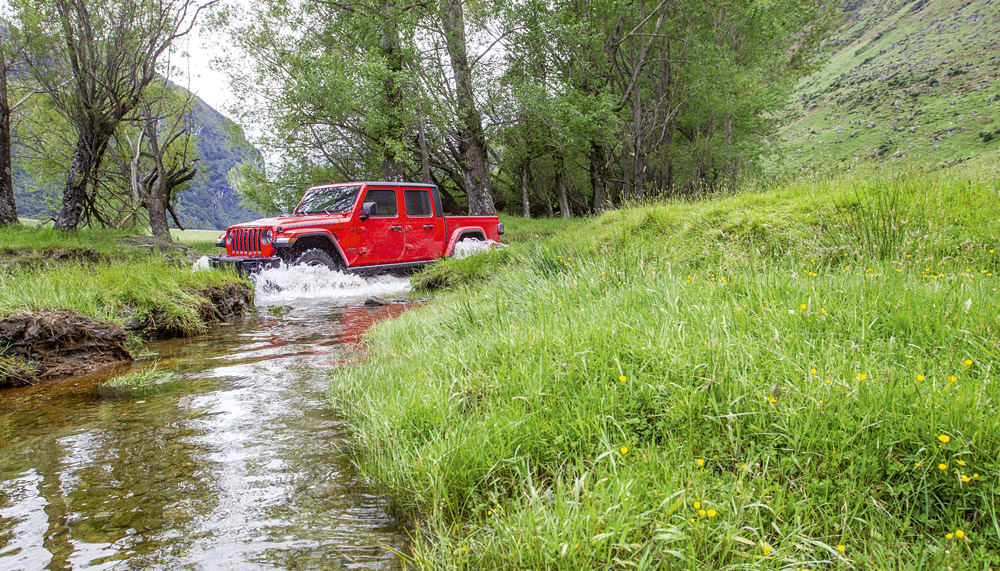Jeep adds a four-door ute to its 4WD ranks.
Story Bruce McMahon
Jeep is a brand with tonnes of history – some great and some ordinary. North America’s World War II military machine became a go-anywhere civilian vehicle, spawning imitators from England to Japan: Land Rovers to LandCruisers. Since 1941, Jeep has added a variety of wagons and utilities, or pick-ups, to the line-up and now a dual-cab, convertible utility joins the ranks.
The Gladiator is based around the four-door Wrangler. This means a square-jawed body, with cargo tray out back and removable roof panels over the cabin. There is no mistaking the family resemblance and style cues paying homage to the original Jeep; the Gladiator has distinctive character, not easily confused among today’s mob of four-door utes.
No-nonsense body design and Jeep’s reputation for 4WD ability also means good off-road capability. The Overland version of the Gladiator sits on 18-inch wheels with 249mm ground clearance, live axles and a clever transfer case that allows traction choices from two-wheel-drive through automatic four-high to locked in four-low.
Drivers sit straight and high – without a tonne of room for the left foot – but there is decent visibility to the front and sides, and an excellent rear-view camera when backing out of trouble. For a 5.5m machine, the Jeep is a poised off-roader over rocks, up the hills and through the mud, though that 3488mm long wheelbase could catch the middle out in some situations.
The Gladiator’s underside is well protected, there is great axle and wheel articulation, smooth-operating disc brakes all round plus hill descent control to aid bush or beach work.
In Australia the Jeep Gladiator arrives with a 209kW petrol engine and 347Nm of torque delivered through an eight-speed automatic transmission. That, plus towing capacity limited to 2700kg, a payload of 527kg for the Overland model and price tags from $75,000, will scratch the Jeep from some shopping lists, although there are other dual cabs with price tags as high.
The upside with the V6 is on-road performance compared to diesel-engine rivals. Nor is the petrol motor handicapped in slow and steady off-roading, thanks in part to good gearing. After a week of town, country, creek crossings and paddock work – with light loads, but not sparing any horses – the Jeep’s computer calculated average consumption at 11.5L per 100km, close enough to the factory’s claimed 11.2L.
While there was little doubt about the Gladiator’s off-road prowess, it is this ute’s on-road ability and comforts, in particular over rough back-country roads, which surprised. On bitumen, gravel or dirt the Jeep is smooth and well-balanced; it soaks up lumps, big and small, with a confidence not always found in this class.
On-road comfort is aided by that longish wheelbase, smart engine, transmission and steering responses. Electronically assisted steering is not super-sharp, needing a tad more turn of the wheel than some, yet once the ute has settled into an out-of-town lope it is quite reassuring.
There is some wind noise from the bluff-nosed Jeep at 100km/h and beyond, not uncommon in pragmatic vehicles, but levels are not excessive and nothing a little extra Jimmy Barnes cannot cover. Road and tyre noise in Overland versions is minimal, helped by the road-biased Bridgestone tyres on this model.
On-road experiences are supported by a suite of safety systems – from blind spot monitoring to adaptive cruise, trailer sway and traction controls. For driver comfort, also important to safety, there are heated exterior mirrors, seats and steering wheel rim.
There is a glovebox, centre console bin, big cup holders and nets on doors for storage, yet few oddment spots up front. A flat and sensible dashboard houses a 20cm screen for satellite navigation, phone hook-ups and entertainment. Traditional analogue instrumentation is backed by digital graphics, including road speed read-outs and travel information.
It is a comfortable cabin for long-distance drives or hill-side scrambles and can be opened wide to the elements with removable roof panels and doors – tie-down straps for the fold-down windscreen are optional, as is one of the best soft tonneau covers; this rolls up to the back of the cabin without the usual fiddles with stays or connections to the 1.5m tray’s edges.
In time for the Gladiator, Jeep Australia’s warranties are now five years/100,000km with lifetime roadside assistance – provided the vehicle is dealer-serviced – by a team of ‘flying doctor’ mechanics to sort dramas anywhere in the country. These moves recognise the need to improve the brand’s reputation and coverage in far-flung areas.
The Jeep Gladiator may never knock Ford’s Ranger or Toyota’s HiLux from atop the sales charts – after all it is petrol-only and pricey, with towing capacity down on rivals. But it is a welcome addition to dual-cab ranks.
This story excerpt is from Issue #134
Outback Magazine: Dec/Jan 2021










